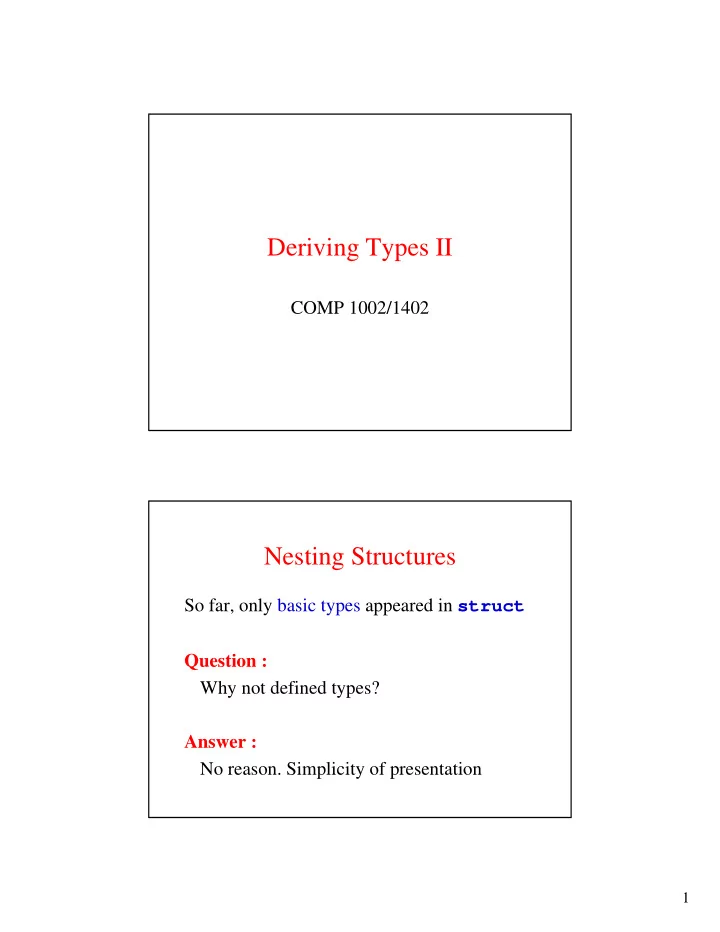

Deriving Types II COMP 1002/1402 Nesting Structures So far, only basic types appeared in struct Question : Why not defined types? Answer : No reason. Simplicity of presentation 1
Nesting Structures Define a STAMP to contain: a DATE and a TIME How to do it Use one struct or type inside the overall struct See following examples... Style: Declare every structure separately! Necessity: Declare before use. 2
Bad Style typedef struct { struct { int month; int day; int year; } date; struct { int hour; int min; int sec; } time; } STAMP; STAMP aStamp; Good Style typedef struct { int month; int day; int year; } DATE; typedef struct { int hour; int min; int sec; } TIME; typedef struct { DATE date; TIME time; } STAMP; STAMP aStamp; 3
Referencing Nested Structures aStamp aStamp.date aStamp.date.month aStamp.date.day aStamp.date.year aStamp.time aStamp.time.hour aStamp.time.min aStamp.time.sec Nested Structure Initialization Initialize each structure with: Nested {} : STAMP aStamp = {{05,10,1936},{23,45,00}}; Or predefined variables: DATE aDate = {05,10,1936}; TIME aTime = {23,45,00}; STAMP aStamp = {aDate, aTime}; 4
Arrays in Structures Defined like any other element Accessed through indices Initialized like a nested (sub)structure Arrays in Structures 5
Accessing Elements STUDENT aStudent; aStudent aStudent.name aStudent.name[1] aStudent.midterm aStudent.midterm[j] aStudent.final Accessing Elements STUDENT *paStudent; paStudent = &aStudent; paStudent->name paStudent->name[1] paStudent->midterm paStudent->midterm[j] paStudent->final 6
Accessing pointers STUDENT aStudent={"John Smith",{92,80,70},87}; int *pScores = aStudent.midterm; int totalScores = *pScores + *(pScores+1) + *(pScores+2); Pointers, Structures and Memory Consider the DATE structure Months should be strings! Should we store the string in every month? Store one pointer in every structure 7
The New Structure typedef struct { char *month; int day; int year; } DATE; The New Structure Every "December" points to the same spot! 8
Array of Structures STUDENT stuAry[50]; Array of Structures int totScore = 0; float average; STUDENT *pStu; STUDENT *pLastStu; … pLastStu = stuAry + 49; /*Address of Last one*/ for (pStu = stuAry; pStu <= pLastAry; pStu++) totScore += pStu->final; average = totScore / 50.0; 9
Structures and Functions 1. Pass individual members (fields) 2. Pass entire structure : BY VALUE 3. Pass address to structure Passing Individual Members 10
Sending the Whole Structure Careful Passing by Value ! Any pointers in the structure ? What about that new DATE class… Pass a DATE to a function by value, In the function change the contents of month, What happens? 11
Passing Whole Structures Unions union like enum & struct allow: 1. A single variable 2. Multiple variables 3. New type definition 12
Union A union variable allows: more than one type of data to occupy its memory! Big enough for the largest of them. Accessed with . Operator (See example - Next page) ( data.num or data.chAry[0] ) Union 13
Unions in Structures Initializing Unions Only the first type declared in union! typedef union { short num; char ch[2]; } SH_CH2; SH_CH2 data = 16706; printf("%d\n%c\n%c\n",num,ch[0],ch[1]); 14
Little Endian, Big Endian Q. What does this code produce? SH_CH2 data = 16706; printf("%d\n%c\n%c\n",num,ch[0],ch[1]); Ans. Two possible outputs! 16706 16706 A B B A Why? (16706) 10 = (0100 0001 0100 0010) 2 Big Endian puts msw before lsw Little Endian puts lsw before msw (Most Significant Word & Least Significant Word) Word is 2 bytes (usually)! 15
Recommend
More recommend